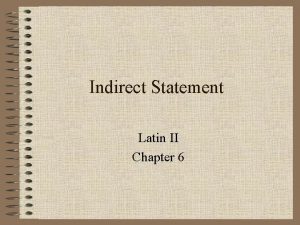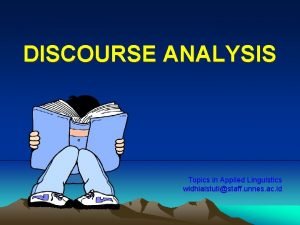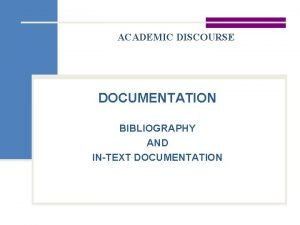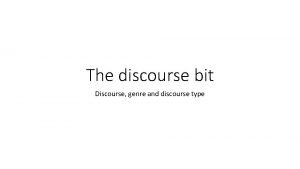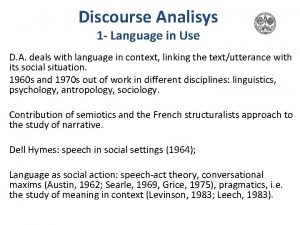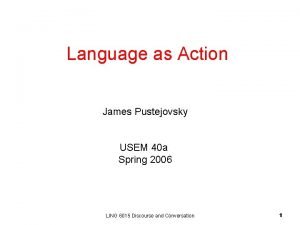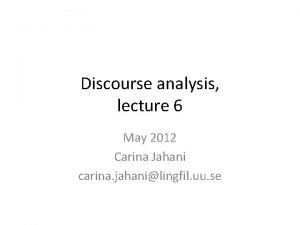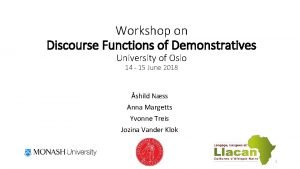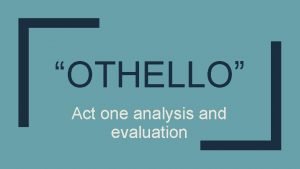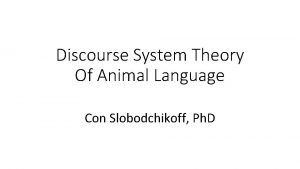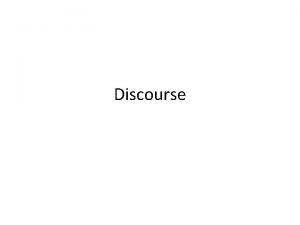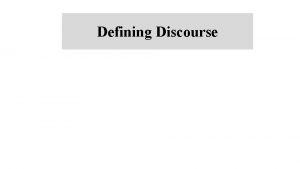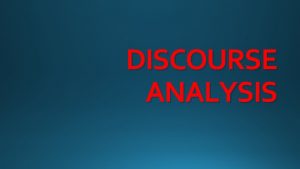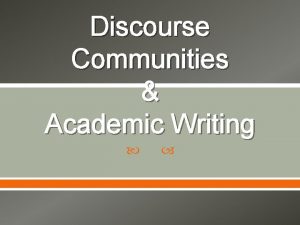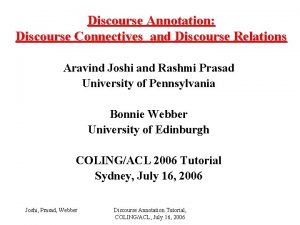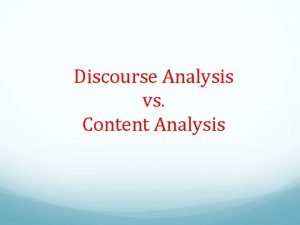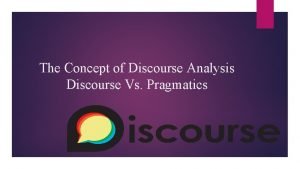What is discourse n n n Discourse is














- Slides: 14

What is “discourse”? n n n Discourse is: language above the sentence or above the clause a continuous stretch of spoken language larger than a sentence, often constituting a coherent unit a stretch of language perceived to be meaningful unified, and purposive; language in use (viewed) as social practice determined by social structures

Structural and functional definitions of discourse n Structural or textual definition of discourse: Discourse is a particular unit of language (above the sentence). n Functional definition of discourse: Discourse is a particular focus of language use.

Structural approach to discourse Find the constituents that have particular relationships with each other and that can occur in a restricted number of arrangements; n Problems: units in which people speak do not always look like sentences, or grammatically correct sentences. Example 1 (From “The Colour Purple”, Alice Wharton) n Jack is tall and kind and don't hardly say anything. Love children. Respect his wife, Odessa, and all Odessa Amazon sisters (Celie’s Diary)

Structural approach to discourse n n n Examples, like Colourless green ideas sleep furiously (Chomsky); Solving the problem: adopt Lyons’s distinction between system-sentences and text – sentences. System sentences are well-formed abstract theoretical sentences generated according to the existing grammar rules; textsentences are context-dependent utterances or parts of utterances which occur in everyday life. The discourse analysis will be concerned with textsentences.

Functional approach to discourse n Roman Jakobson: language performs six functions: ü Addressor(emotive); ü Context (referential) ü Addressee (conative); ü Contact (phatic); ü Message (poetic); ü Code (metalinguistic).

Functional approach to discourse Utterances may have multiple functions; n The major concern: discourse analysis can turn out into a more general and broader analysis of language functions. Or it will fail to make a special place for the analysis of relationships between utterances. n

Recent approach to DA Discourse is no longer studies for its own sake. Discourse is viewed as a social practice. n M. Foucault, N. Fairclough n

Recent approach to DA n Discourse is characterised as: produced/consumed/monitored by social actors (producers/receivers of social practices); ü shaped by social structures; ü with social implications; ü socially valued and regulated (production, reception and circulation). ü

Recent approach to DA n If in traditional studies discourses were analysed in relation to social processes that form them, then recently researchers started talking about bidirectional and complex relations between discourses and social practices: Discourses of food “Healthy Food” Social Practice Healthy lifestyle

Pragmatics n n n Based primarily on the ideas of Paul Grice: People interact having minimal assumptions (implicatures) about one another; Two types of implicatures: conventional and conversational; Conventional implicatures do not require any particular context in order to be understood (or inferred); Conversational implicatures are context – dependant. What is implied varies according to the context of an utterance.

Pragmatics To explain HOW we interpret implicatures Grice introduced the Cooperative Principal: n Make your contribution such as required, at the stage at which it occurs, by the accepted purpose or direction of the talk exchange in which you are engaged. n

Pragmatics n n n There are four conversational maxims which help us to realize the implicit meaning if an utterance: Maxim of Quantity: Make your contributions as informative as required (for the current purposes of the exchange). Do not make your contribution more informative than required. Maxim of Quality: Do not say what you believe to be false. Do not say something if you lack adequate evidence.

Pragmatics n Maxim of Relation: Be relative. n Maxim of Manner: Be perspicuous (or express your ideas clearly) Avoid obscurity of expressions (= do not use expressions which are not clear or easy to understand); Avoid ambiguity (= presence of more than one meaning); Be brief (avoid unnecessary usage of too many words); Be orderly.

Pragmatics n The contribution of Gricean pragmatics to DA is a set of principles that constrains speakers’ sequential choices in a text and allows hearers to recognize speaker’s intentions.
 Discourse analysis in linguistics
Discourse analysis in linguistics Latin indirect object
Latin indirect object Discourse analysis topics
Discourse analysis topics Discursive competence
Discursive competence Discourse and syntax
Discourse and syntax Discourse documentation
Discourse documentation Discourse community examples
Discourse community examples Field tenor and mode in discourse analysis
Field tenor and mode in discourse analysis Insertion sequence in conversation analysis
Insertion sequence in conversation analysis Speech act theory
Speech act theory Discourse deixis examples
Discourse deixis examples Discourse
Discourse What is critical discourse analysis
What is critical discourse analysis Othello act 1 analysis
Othello act 1 analysis Discourse system
Discourse system

